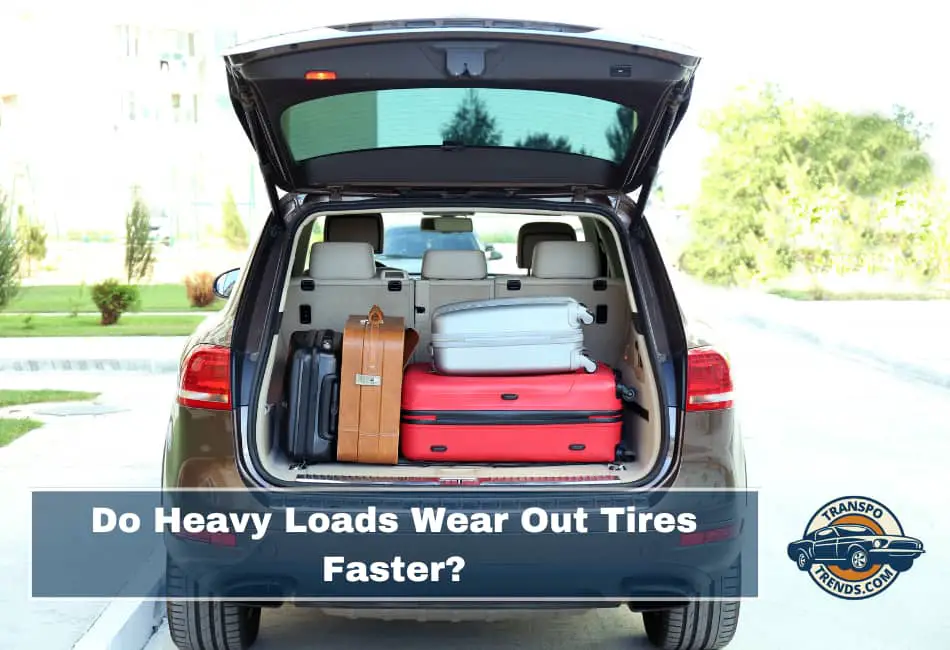Tires do more than just keep your vehicle moving—they are your first line of defense when it comes to safety, stability, and control. But not all driving conditions place equal stress on them.
For vehicles that regularly carry heavy loads, like trucks, SUVs, or work vans, tire wear can become a serious issue if not properly managed.
The extra weight affects how your tires contact the road, which in turn influences how quickly and unevenly the tread wears down.
In this guide, we take a close look at how vehicle weight and load distribution play a critical role in tire treadwear.
Whether you are towing equipment, transporting cargo, or simply driving a larger vehicle, understanding these factors can help you protect your tires and get the most out of them.
We will also share straightforward tips for maintaining tire health when handling heavy loads—because longer-lasting tires mean safer, smoother rides.
Let us explore how load impacts tread life and what you can do to minimize wear.
Understanding Vehicle Weight, Load, and Treadwear
Tire treadwear refers to the gradual erosion of the tread—the patterned surface of the tire that grips the road. This tread is vital for maintaining traction, especially in wet or slippery conditions, and for ensuring even wear across the tire’s surface.
When tread wears down too much, it can compromise your vehicle’s handling, increase braking distances, and heighten the risk of hydroplaning.
Most tires come with treadwear indicators—small bars that become visible when the tread depth is low—signaling that it is time for a replacement.
Vehicle weight includes the base weight of the car (known as curb weight), passengers, cargo, and any towed load.
Load distribution refers to how this weight is spread across the tires, which can be even or uneven depending on how cargo is placed.
For trucks and SUVs, curb weight often ranges from 4,000 to 6,000 pounds, and adding cargo or towing a trailer can significantly increase the total load.
The Gross Vehicle Weight Rating (GVWR) is the maximum total weight a vehicle can safely carry, including curb weight, passengers, cargo, and fuel, and exceeding this limit can lead to serious tire issues.
Understanding how weight and load affect treadwear is crucial, especially for drivers of heavier vehicles. Research from the National Highway Traffic Safety Administration (NHTSA) indicates that overloading can reduce tire lifespan by up to 25 percent and increase the risk of failure, particularly in trucks and SUVs used for towing or hauling.
Let us explore the specific ways weight impacts your tires and how to manage it effectively.
How Weight and Load Affect Treadwear
Vehicle weight and load impact treadwear through several mechanisms, each contributing to faster wear and potential safety risks:
Increased Contact Pressure
Heavier loads increase the pressure on the tire’s contact patch—the area of the tire that touches the road. This heightened pressure leads to greater friction between the tire and the road surface, accelerating treadwear.
For example, a truck carrying 2,000 pounds of cargo exerts far more force on its tires than one carrying 500 pounds, causing the tread to wear down more quickly under the added strain.
Heat Generation
Extra weight causes tires to flex more as they roll, generating heat that can degrade the rubber compound over time. This heat buildup accelerates treadwear, especially during long drives or at high speeds.
Overloading can raise tire temperatures significantly, and prolonged exposure to this heat can weaken the tire’s structure, leading to faster wear and a higher risk of failure.
Uneven Wear Patterns
Uneven load distribution can cause specific tires to wear faster than others. For instance, if you overload the rear axle of a truck by placing heavy cargo in the bed without balancing the load, the rear tires will bear more weight and wear out more quickly than the front tires.
This can result in uneven wear patterns, such as cupping—small dips in the tread—or excessive shoulder wear, which reduces traction and stability.
Sidewall Stress
Beyond treadwear, heavy loads place additional stress on the tire’s sidewalls—the vertical part of the tire between the tread and the wheel.
This stress can lead to cracks, bulges, or other damage, increasing the risk of blowouts. While the tread may still have some life, sidewall damage can render the tire unsafe, necessitating early replacement.
Consequences of Overloading
Overloading a vehicle has several negative effects on tires, impacting both performance and safety:
Reduced Tire Lifespan
Tires wear out faster under heavy loads, requiring earlier replacement. A tire rated for 60,000 miles under normal conditions might last only 45,000 miles if consistently overloaded, costing you more in the long run.
Uneven Wear
Overloading specific axles or sides causes uneven wear patterns, such as cupping or shoulder wear, which can reduce traction and make your vehicle harder to control.
Increased Blowout Risk
Excessive weight and heat weaken the tire’s structure, raising the chance of sudden failure, especially at highway speeds where the consequences can be severe.
Higher Fuel Consumption
Overloaded vehicles face increased rolling resistance—the force required to keep the tires moving—which lowers fuel efficiency and adds to operating costs.
Suspension Strain
Heavy loads can stress suspension components like shocks and struts, leading to misalignment or uneven tire contact with the road, further accelerating wear.
Managing Heavy Loads to Minimize Treadwear
Protecting your tires from excessive wear starts with managing vehicle weight and load effectively. Here are practical strategies to help you minimize treadwear and extend tire life:
Check Load Capacity
Before loading your vehicle, verify its Gross Vehicle Weight Rating (GVWR) and the load ratings of your tires.
The GVWR is typically found on the driver’s door placard, while the tire load index is marked on the sidewall (for example, a load index of 120 corresponds to 3,086 pounds per tire).
Ensure the total weight—including cargo, passengers, and fuel—stays within these limits to avoid overloading.
Distribute Loads Evenly
Proper load distribution is key to preventing uneven wear. Place heavier items low and centered to balance the weight across all tires, rather than stacking cargo heavily on one side or axle.
For example, if you are loading a truck bed, spread the weight evenly between the front and rear axles to avoid overburdening the rear tires.
This simple step can help all tires wear at a similar rate, extending their overall lifespan.
Maintain Proper Tire Pressure
Tire pressure is critical when carrying heavy loads. Overloading can exacerbate the effects of underinflation, causing the edges of the tread to wear faster, while overinflation can lead to excessive center wear.
Check tire pressure monthly, and adjust it to the manufacturer’s recommendation for loaded conditions, which is often higher than for unloaded scenarios. These recommendations are typically found on the vehicle’s placard or in the owner’s manual.
Rotate Tires Regularly
Rotating your tires every 5,000 to 7,000 miles helps ensure even wear, especially for vehicles carrying consistent loads.
Use patterns like forward cross—swapping front left with rear right, and front right with rear left—or an X-pattern, swapping front left with rear left, and front right with rear right.
Regular rotation prevents specific tires from wearing out faster due to uneven load distribution, maximizing their lifespan.
Inspect Tires Frequently
Regular inspections can catch issues early, preventing further damage. Check your tires monthly for uneven wear, sidewall damage, or embedded objects like nails.
Use the penny test to monitor tread depth: insert a penny into the tread groove with Lincoln’s head upside down.
If you can see the top of his head, the tread is below 2/32 inch, and it is time to replace the tire. Addressing issues promptly can prevent premature wear and ensure your tires remain safe.
Monitor Suspension Health
Heavy loads can strain suspension components like shocks and struts, leading to uneven tire contact with the road and accelerated wear.
Inspect your suspension regularly, looking for signs like excessive bouncing or swaying while driving. If you notice these issues, have the suspension components checked and replace worn parts promptly to maintain even tire wear and improve overall vehicle performance.
Choosing Tires for Heavy Loads
Selecting the right tires is critical for vehicles that frequently carry heavy loads, such as trucks and SUVs. Here are some considerations to help you choose tires that can handle the extra weight:
Load Rating
Choose tires with a load index that matches or exceeds your vehicle’s needs. For example, if your truck tows 5,000 pounds, ensure your tires are rated to handle that weight.
The load index is marked on the tire sidewall, and you can cross-reference it with a load index chart to determine the weight capacity per tire.
Tire Type
- Light Truck (LT) Tires: Designed specifically for trucks and SUVs, LT tires feature reinforced sidewalls and higher load capacities, making them ideal for heavy loads.
- All-Terrain Tires: Suitable for mixed on- and off-road use, these tires offer durability for heavy loads while providing good traction in various conditions.
- Heavy-Duty Tires: Built for commercial vehicles or frequent towing, heavy-duty tires use robust compounds to resist wear under extreme loads.
Tread Design
Opt for tires with deeper treads and durable compounds, which provide better traction and longevity under load.
Avoid performance tires for heavy loads, as they prioritize grip over durability and may wear out quickly under the added stress.
Compound Considerations
Harder compounds with silica fillers resist wear better under heavy loads, making them ideal for highway hauling.
Softer compounds may wear faster but offer better grip for off-road or wet conditions, so choose based on your primary driving needs.
Final Thoughts
Managing vehicle weight and load is about more than just extending the life of your tires—it is about ensuring your safety and comfort on the road.
Overloading can lead to uneven wear, reduced traction, and a higher risk of blowouts, especially for trucks and SUVs that regularly carry heavy loads.
By adopting proper load distribution, selecting tires designed for heavy loads, and maintaining your tires and suspension, you can avoid costly replacements and maintain performance.

